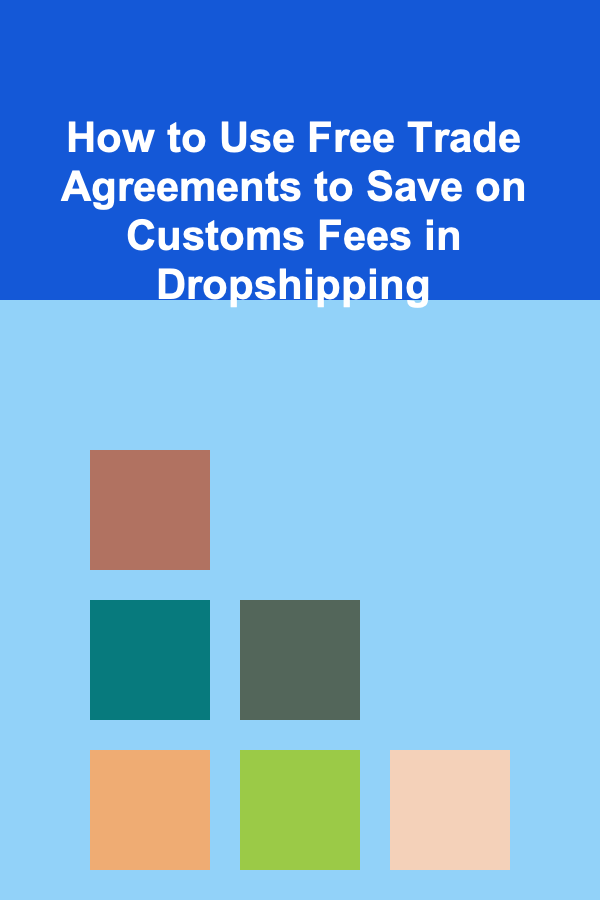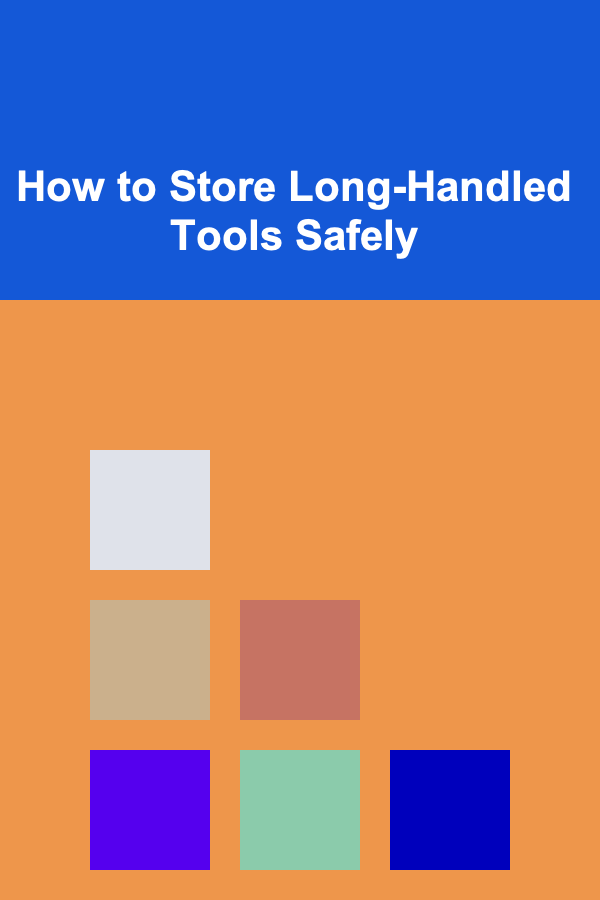
How to Use Free Trade Agreements to Save on Customs Fees in Dropshipping
ebook include PDF & Audio bundle (Micro Guide)
$12.99$5.99
Limited Time Offer! Order within the next:

Dropshipping is a popular business model that allows entrepreneurs to sell products without maintaining inventory. However, like any other form of international trade, dropshipping involves navigating customs fees, import duties, and taxes, which can significantly eat into profit margins. One of the most effective ways to reduce these expenses is by utilizing Free Trade Agreements (FTAs).
In this actionable guide, we'll explore how you can leverage FTAs to save on customs fees when operating a dropshipping business. We'll cover the basics of FTAs, how they work, and practical steps to implement them in your dropshipping strategy.
What Are Free Trade Agreements (FTAs)?
A Free Trade Agreement (FTA) is a treaty between two or more countries that aims to reduce or eliminate barriers to trade, such as tariffs, import quotas, and customs duties. FTAs are designed to encourage economic cooperation between member countries by promoting easier and cheaper trade.
When an FTA is in place between the countries where your supplier is based and the country you're selling to, your dropshipping business may benefit from reduced customs fees, lower import duties, or even exemptions on specific goods. This can result in substantial cost savings, which can be passed on to your customers or retained as profit.
How Free Trade Agreements Work
FTAs generally have a few key provisions that directly impact customs fees:
- Reduction of Tariffs: FTAs typically lead to the reduction or elimination of tariffs between member countries, which can lower the cost of importing goods.
- Rules of Origin: FTAs often contain rules that specify how much of a product must be sourced from within the member countries to qualify for reduced tariffs. This is known as the "rules of origin." By meeting these rules, you can import goods at a lower cost.
- Simplified Customs Procedures: FTAs often streamline customs procedures, making it faster and easier to clear goods through customs, thus reducing additional costs associated with customs processing.
- Trade Facilitation Measures: Many FTAs include provisions to facilitate trade by reducing paperwork, improving transparency, and setting standards for quality, which can lower costs and improve efficiency.
Why Dropshippers Should Care About FTAs
As a dropshipper, you are responsible for handling the importation of goods from your supplier to the customer. This means that when you are sourcing products internationally, you may incur customs fees and import duties that can significantly affect your profit margins. These fees can vary depending on the countries involved, the type of product, and the trade regulations in place.
By leveraging FTAs, you can reduce or eliminate many of these costs. For instance, if you're dropshipping from a country with an FTA to the customer's country, you may qualify for reduced tariffs or duty-free entry for certain products, which could lower your overall costs. This makes your business more competitive and profitable, especially in markets where customs fees are a major consideration.
How to Leverage FTAs in Dropshipping
To effectively leverage FTAs in your dropshipping business, follow these actionable steps:
1. Identify Relevant Free Trade Agreements
The first step is to research the FTAs that apply to the countries you're involved with in your dropshipping operations. Start by identifying the countries where your suppliers are located and where your customers are based. Then, check if there are any active FTAs between these countries.
Some key FTAs include:
- North American Free Trade Agreement (NAFTA) (now replaced by USMCA): Covers the United States, Canada, and Mexico.
- European Union Free Trade Area (EUFTA): Covers all EU member states.
- Comprehensive and Progressive Agreement for Trans-Pacific Partnership (CPTPP): Covers countries such as Japan, Australia, and Canada.
- Regional Comprehensive Economic Partnership (RCEP): Covers Southeast Asian nations and China.
You can usually find details about these FTAs on the official government websites or through trade organizations in the relevant countries.
2. Understand the Rules of Origin
Once you know which FTAs apply to your business, it's crucial to understand the rules of origin. These rules specify the criteria that a product must meet to be eligible for preferential tariff treatment under the FTA. The rules often involve two main aspects:
- Substantial Transformation: The product must undergo significant processing or manufacturing within the FTA member countries to qualify.
- Value Content: The product must contain a certain percentage of materials or components sourced from the FTA member countries.
For example, if you're sourcing products from China to sell to the United States under the US-China trade agreement, you would need to confirm that the product qualifies for preferential tariff treatment based on the rules of origin. If the product is manufactured in China but uses raw materials sourced from another non-FTA country, it may not qualify for the reduced customs duties.
Understanding these rules ensures that you can correctly determine which products are eligible for duty-free or reduced-tariff treatment, helping you save money on customs fees.
3. Ensure Proper Documentation
FTAs usually require certain documentation to prove that your products qualify for the preferential treatment. This may include:
- Certificates of Origin: These documents prove that the products were manufactured in or sourced from an FTA member country. In some cases, you may need to provide a statement of origin from your supplier.
- Import Declarations: When shipping goods internationally, you'll need to submit declarations that outline the origin of the products and their value.
- Commercial Invoices: Detailed invoices that specify the price, description, and origin of goods.
Ensure that both you and your suppliers are fully aware of the documentation requirements and that all paperwork is in order. Failure to provide the correct documentation could result in delays, additional customs fees, or even penalties.
4. Calculate Potential Savings
Once you've identified applicable FTAs and understood the rules of origin and documentation requirements, calculate the potential savings. The amount you save on customs fees will depend on the type of goods you're importing, the specific provisions of the FTA, and the tariff rates in your customer's country.
For example, if you are dropshipping electronics and the FTA allows for a reduction in tariffs, you could save a significant amount on each unit. This savings can either be passed on to your customers in the form of lower prices or retained as profit.
You can use tools such as the HS Code lookup (Harmonized System Code) to understand the specific duties associated with different product categories. This can help you determine which products are most eligible for tariff reductions under FTAs.
5. Optimize Shipping and Logistics
In addition to reducing customs fees, FTAs often streamline shipping and logistics processes, making it easier and cheaper to get your products into your customers' hands. FTAs often provide for:
- Lower customs clearance fees: In many cases, FTAs simplify the customs process and reduce the fees associated with clearing goods through customs.
- Faster transit times: With reduced barriers to trade, goods often move more quickly between FTA member countries, which can lead to faster shipping times for your customers.
- Better logistics partnerships: Countries in FTAs may offer enhanced logistics services and infrastructure, reducing the cost and complexity of cross-border shipping.
Leveraging these benefits can improve your customer satisfaction by offering faster delivery times and lower shipping costs.
6. Stay Updated on Changes in FTAs
FTAs are dynamic agreements, and new ones are constantly being negotiated and ratified. Changes in trade agreements or the introduction of new FTAs could impact your business, so it's essential to stay informed about the latest developments. This will help you continuously optimize your business by taking advantage of any new savings opportunities.
You can stay updated by regularly checking government websites, subscribing to industry newsletters, or consulting with trade experts and customs brokers.
Conclusion
Using Free Trade Agreements (FTAs) is one of the smartest ways to save on customs fees in your dropshipping business. By understanding the FTAs applicable to your business, ensuring your products meet the necessary rules of origin, and properly documenting your shipments, you can significantly reduce your costs.
Incorporating FTAs into your dropshipping strategy not only saves you money but also gives you a competitive edge by lowering your product prices or increasing your profit margins. With the right approach and constant monitoring, you can make FTAs a key tool in optimizing your dropshipping business's financial efficiency and growth.
Reading More From Our Other Websites
- [Home Holiday Decoration 101] How to Create a Magical Christmas Eve Experience
- [Home Cleaning 101] How to Clean Your Bathroom Like a Pro
- [Tie-Dyeing Tip 101] Beyond Cotton: Tie-Dye Techniques for Denim, Silk, and Synthetic Fabrics
- [Organization Tip 101] How to Plan Fun and Engaging Activities for Seniors
- [Personal Investment 101] How to Make Money with AI and Deep Learning in the Healthcare Industry
- [Survival Kit 101] Best Survival Kit for Emergency Medical Professionals Working Remote Clinics
- [Personal Care Tips 101] How to Understand Perfume Concentrations: From Parfum to Cologne
- [Tie-Dyeing Tip 101] Reverse Tie-Dye: Turning Classic Patterns Inside Out
- [Gardening 101] Seasonal Trellis Layouts: Planning for Spring Blooms and Summer Greens
- [Personal Investment 101] How to Set Realistic Investment Goals and Achieve Them

How to Store Long-Handled Tools Safely
Read More
The Video Editor's Guide: Mastering Editing Techniques and Storytelling
Read More
Using Social Media Wisely During Your Job Search
Read More
**How To Develop Strategic Partnerships for Small Business Growth**
Read More
Supporting Children's Visual Perceptual Skills: A Comprehensive Guide
Read More10 Tips for Accurate Freelance Income Tracking
Read MoreOther Products

How to Store Long-Handled Tools Safely
Read More
The Video Editor's Guide: Mastering Editing Techniques and Storytelling
Read More
Using Social Media Wisely During Your Job Search
Read More
**How To Develop Strategic Partnerships for Small Business Growth**
Read More